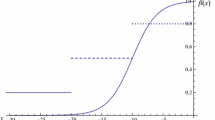Abstract
In this work, we study a single-item inventory model where shortages are allowed. A known constant fraction of the demand during the stockout period is backlogged, and the rest are lost sales. Usually, in the literature on inventory control, the unit backorder cost is considered to be a linear function of the waiting time until the customer gets the item. However, in some real-world situations, the unit cost of a backorder may not be linear. To model this situation, we develop a new approach by considering that the backlogging unit cost is a nondecreasing, continuous, and positive function of the amount of time the customers wait before receiving the item. Our objective is to maximize the average profit per unit time. An effective solution procedure to determine the optimal policy and the maximum average profit is developed. Numerical examples, which help us to understand the theoretical results, are also presented.
Similar content being viewed by others
References
Abad PL (2000) Optimal lot size for a perishable good under conditions of finite production and partial backordering and lost sale. Comput Ind Eng 38:457–465
Balkhi ZT (2000) On the optimal production stopping and restarting times for an EOQ model with deterioration items. J Oper Res Soc 51:999–1003
Balkhi ZT, Goyal SK, Giri BC (2001) Some notes on the optimal production stopping and restarting times for an EOQ model with deterioration items. J Oper Res Soc 52:1300–1301
Çetinkaya S, Parlar M (1998) Nonlinear programming analysis to estimate implicit inventory backorder costs. J Optim Theory Appl 97:71–92
Chen F, Zheng Y-S (1993) Inventory models with general backorder costs. Eur J Oper Res 65:175–186
Chu P, Chen PS (2002) A note of inventory replenishment policies for deteriorating items in an exponentially declining market. Comput Oper Res 29:1827–1842
Chu P, Chung KJ (2004) The sensitivity of the inventory model with partial backorders. Eur J Oper Res 152:289–295
Giri BC, Jalan AK, Chaudhuri KS (2005) An economic production lot size model with increasing demand, shortages and partial backlogging. Int Trans Oper Res 12:235–245
Goyal SK, Giri BC (2003) The production-inventory problem of a product with time varying demand, production and deterioration rates. Eur J Oper Res 147:549–557
Hadley G, Whitin TM (1963) Analysis of inventory systems. Prentice Hall, Englewood Cliffs
Harris FW (1913) How many parts to make at once. Fact Mag Manag 10:135–136, 152 (reprinted in Oper Res 38, 947–950)
Hax AC, Candea D (1984) Production and inventory management. Prentice Hall, Englewood Cliffs
Hu WT, Kim SL, Banerjee A (2009) An inventory model with partial backordering and unit backorder cost linearly increasing with the waiting time. Eur J Oper Res 197:581–587
Johnson LA, Montgomery DC (1974) Operations research in production planning, scheduling and inventory control. Wiley, New York
Jolai F, Tavakkoli-Moghaddam R, Rabbani M, Sadoughian MR (2006) An economic production lot size model with deteriorating items, stock-dependent demand, inflation and partial backlogging. Appl Math Comput 181:380–389
Leung KN (2008) Technical note: a use of the complete squares method to solve and analyze a quadratic objective function with two decision variables exemplified via deterministic inventory model with a mixture of backorders and lost sales. Int J Prod Econ 113:275–281
Lo ST, Wee HM, Huang WC (2007) An integrated production-inventory model with imperfect production processes and Weibull distribution deterioration under inflation. Int J Prod Econ 106:493–505
Love FS (1979) Inventory control. McGraw-Hill, New York
Montgomery DC, Bazaraa MS, Keswani AK (1973) Inventory models with a mixture of backorders and lost sales. Nav Res Log Q 20:255–263
Naddor E (1982) Inventory systems. Wiley, New York
Oral M, Salvador MS, Reisman A, Dean BV (1972) On the evaluation of shortage costs for inventory control of finished good. Manag Sci 18:B344–351
Park KS (1982) Inventory model with partial backorders. Int J Syst Sci 13:1313–1317
Pentico DW, Drake MJ (2009) The deterministic EOQ with partial backordering: a new approach. Eur J Oper Res 194:102–113
Rosenberg D (1979) A new analysis of a lot size model with partial backlogging. Nav Res Log Q 26:346–353
Rosling K (1999) The square-root algorithm for single-item inventory optimization. Working paper, Växjö University
Rosling K (2002) Inventory cost rate functions with nonlinear shortage costs. Oper Res 50:1007–1017
San-José LA, Sicilia J, García-Laguna J (2003) A new perspective on the partial backlogging EOQ model. In: Actas del 27 congreso nacional de estadística e investigación operativa, Lérida, Spain, pp 3384–3392 (ISBN 84-8409-955-5)
San-José LA, García-Laguna J, Sicilia J (2008) A backorders-lost sales EOQ inventory model with quadratic shortage cost. In: Proceedings of the Pyrenees international workshop on statistics, probability and operations research, Jaca, Spain, pp 165–174 (ISBN 978-84-9521-18-0)
San-José LA, Sicilia J, García-Laguna J (2009) A general model for EOQ inventory systems with partial backlogging and linear shortage costs. Int J Syst Sci 40:59–71
Schwartz BL (1966) A new approach to stockout penalties. Manag Sci 12:B538–544
Schwartz BL (1970) Optimal inventory policies in perturbed demand models. Manag Sci 16:B509–518
Walter CK, Grabner JR (1975) Stock costs models: Empirical test in a retail situation. J Mark 39:56–60
Wee HM (1999) Deteriorating inventory model with quantity discount, pricing and partial backordering. Int J Prod Econ 59:511–518
Yan H, Cheng TCE (1998) Optimal production stopping and restarting times for an EOQ model with deterioration items. J Oper Res Soc 49:1288–1295
Yang GK (2007) Note on sensitivity analysis of inventory model with partial backorders. Eur J Oper Res 177:865–871
Author information
Authors and Affiliations
Corresponding author
Rights and permissions
About this article
Cite this article
San-José, L.A., García-Laguna, J. & Sicilia, J. An economic order quantity model with partial backlogging under general backorder cost function. TOP 17, 366–384 (2009). https://doi.org/10.1007/s11750-009-0108-1
Received:
Accepted:
Published:
Issue Date:
DOI: https://doi.org/10.1007/s11750-009-0108-1




